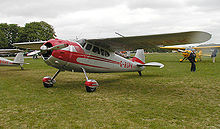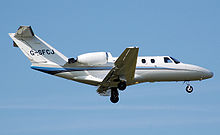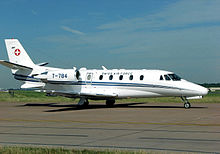- Cessna
-
Cessna Aircraft Company 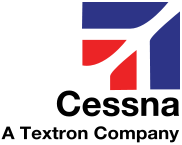
Type Subsidiary Industry Aerospace Founded 1927 Headquarters Wichita, Kansas Key people Scott A. Ernest (CEO from 31 May 2011[1] Products General aviation aircraft
Business jetsEmployees 8,500 (2011)[2] Parent Textron Subsidiaries Columbia Aircraft Website cessna.com 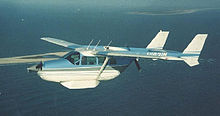 Cessna 337 Skymaster, a "push-pull" aircraft
Cessna 337 Skymaster, a "push-pull" aircraft
 1979 Cessna 340A
1979 Cessna 340A
 1977 Cessna 404 Titan II
1977 Cessna 404 Titan II
The Cessna Aircraft Company is an airplane manufacturing corporation headquartered in Wichita, Kansas, USA. Their main products are general aviation aircraft. Although they are the most well known for their small, piston-powered aircraft, they also produce business jets. The company is a subsidiary of the U.S. conglomerate Textron.
Contents
History
The company traces its history to June 1911, when Clyde Cessna, a farmer in Rago, Kansas, built a wood-and-fabric plane and became the first person to build and fly an aircraft between the Mississippi River and the Rocky Mountains. Cessna started his aircraft ventures in Enid, Oklahoma, testing many of his early planes on the salt flats. When bankers in Enid refused to lend him more money to build his planes, he moved to Wichita.[3]
Cessna Aircraft was formed in 1927 when Clyde Cessna and Victor Roos became partners in the Cessna-Roos Aircraft Company. In the same year, the Secretary of State approved a name change to Cessna Aircraft Company.[4] The Cessna DC-6 earned certification on October 29, 1929, sharing this day in history with the stock market crash of 1929.[5]
Cessna Aircraft Company closed its doors from 1932 until 1934 due to the state of the economy. In 1934, Dwane Wallace, with the help of his brother Dwight, took control of the company and began the process of building it into what would become a global success.[6] In 1933, Cessna CR-3 custom racer took its first flight. The plane won the 1933 American Air Race in Chicago and later set a new world speed record for engines smaller than 500 cubic inches by averaging 237 mph (381 km/h).[7] In 1937, the Cessna C-37 was introduced as Cessna's first seaplane when equipped with Edo floats.[8]
In 1940, the U.S. Army gave Cessna their largest order to date, when they ordered 33 specially equipped Cessna T-50s. Later this same year, the Royal Canadian Air Force placed an additional order for 180 T-50s.[9]
1946 saw Cessna return to commercial production after the revocation of wartime production restrictions (L-48) with the release of the Model 120 and Model 140. The approach was to indroduce a new line of all-metal aircraft that used production tools, dies and jigs rather than the hand-built process used older tube and fabric construction.[10] [11] In 1948 the Model 140 was named by the US Flight Instructors Association, as the "Outstanding Plane of the Year".[12]
1955 saw Cessna's first helicopter, the Cessna CH-1, receive FAA type certification.[13] In 1956, Cessna released the Cessna 172 which went on to become the most produced airplane in history.[14]
In 1960, Cessna affiliated itself with Reims Aviation of Reims, France.[15] 1963 saw Cessna produce its 50,000 airplane, a Cessna 172.[16] Cessna's first business jet, the Cessna Citation I performed its maiden flight on September 15, 1969.[17]
In 1975, Cessna produced its 100,000 single engine airplane.[18]
In 1985, Cessna became a wholly owned subsidiary of General Dynamic Corporation. Production of the Cessna Caravan began.[19]
In 1992, General Dynamics announced the sale of Cessna to Textron Inc.[20]
On 27 November 2007, Textron announced that Cessna had purchased the bankrupt Columbia Aircraft company for US$26.4M and would continue production of the Columbia 350 and 400 as the Cessna 350 and Cessna 400 at the Columbia factory in Bend, Oregon.[21][22]
Chinese production controversy
On 27 November 2007 Cessna announced the new Cessna 162 would be made in the People's Republic of China by Shenyang Aircraft Corporation, which is a subsidiary of China Aviation Industry Corporation I (AVIC I), a Chinese government-owned consortium of aircraft manufacturers.[23] By manufacturing the aircraft in China, Cessna reports it saved USD$71,000 in production costs per aircraft, or about 40% of the cost. A second reason cited for moving production to Shenyang Aircraft Corporation was Cessna had no plant capacity available in the USA at the time.[24]
Cessna received a high degree of negative feedback from 162 customers and potential customers regarding this decision. Complaints centered on the recent problems with Chinese production of other consumer products, China's human rights record, exporting of jobs, and China's less than friendly political relationship with the USA.[25] The backlash surprised Cessna and resulted in a company public relations campaign to try to explain the decision from a business perspective and assure customers that quality of the aircraft will not be compromised.[26] The reaction to the explanations and assurances has been overwhelmingly negative, although a small number of customers have applauded the production in China.[25]
In early 2009 the company attracted further criticism for continuing plans to build the 162 in China while laying off large numbers of workers in the USA.[27]
2008-10 economic crisis
The company's business suffered notably during the late-2000s recession, laying off more than half its workforce between January 2009 and September 2010.
On 4 November 2008 Cessna's parent company, Textron, indicated that Citation production would be reduced from the original 2009 target of 535 "due to continued softening in the global economic environment" and that this would result in an undetermined number of lay-offs at Cessna.[28]
On 8 November 2008, at the AOPA Expo, CEO Jack Pelton indicated that Cessna sales of aircraft to individual buyers had fallen but piston and turboprop sales to business had not. "While the economic slowdown has created a difficult business environment, we are encouraged by brisk activity from new and existing propeller fleet operators placing almost 200 orders for 2009 production aircraft," Pelton stated.[29][30]
On 13 November 2008, Cessna announced that a total of 665 jobs would be cut at its Wichita and Bend, Oregon plants starting in January 2009. The Cessna factory at Independence, Kansas, which builds the Cessna piston-engined aircraft and the Cessna Mustang, was not forecast to see any lay-offs, but one third of the workforce at the former Columbia Aircraft facility in Bend was laid off. This included 165 of the 460 employees who built the Cessna 350 and 400. The remaining 500 jobs were eliminated at the main Cessna Wichita plant.[31]
In January 2009 the company announced 2,000 additional layoffs, bringing the total to 4,600. The job cuts included 120 at the Bend, Oregon facility reducing the plant that built the Cessna 350 and 400 to fewer than half the number of workers that it had when Cessna bought it. Other cuts included 200 at the Independence, Kansas plant that builds the single-engined Cessnas and the Mustang, reducing that facility to 1,300 workers.[32]
On 29 April 2009 the company announced that it was suspending the Citation Columbus program and closing the Bend, Oregon facility. The Columbus program was finally cancelled in early July 2009. The company said "Upon additional analysis of the business jet market related to this product offering, we decided to formally cancel further development of the Citation Columbus". With the 350 and 400 production moving to Kansas, the company indicated that it would lay off 1,600 more workers, including the remaining 150 employees at the Bend plant and up to 700 workers from the Columbus program.[33][34]
In early June 2009 Cessna announced that it would lay-off an additional 700 salaried employees, bringing the total number of lay-offs to 7600 or more than half the company's workers.[35]
In December 2009 the company announced that it will close its three Columbus, Georgia manufacturing facilities between June 2010 and December 2011. The closures will include the new 100,000-square-foot (9,300 m2) facility that was opened in August 2008 at a cost of US$25M, plus the McCauley Propeller plant. These closures will result in total job losses of 600 in Georgia. Some of the work will be relocated to Cessna's Independence, Kansas or Mexican facilities.[36]
Cessna's parent company Textron posted a loss of US$8M in the first quarter of 2010, largely driven by continuing low sales at Cessna, which were down 44%. Cessna's workforce remained 50% laid-off and CEO Jack Pelton stated that he expected the recovery to be long and slow.[37]
In September 2010 Cessna CEO Jack Pelton announced a further 700 lay-offs, bringing the total to 8,000 jobs lost. Pelton indicated this round of layoffs was due to a "stalled [and] lackluster economy" and noted that while the number of orders cancelled for jets has been decreasing new orders have not met expectations. Pelton added "our strategy is to defend and protect our current markets while investing in products and services to secure our future, but we can do this only if we succeed in restructuring our processes and reducing our costs."[38]
2011
On 2 May 2011 CEO Jack Pelton retired. The new CEO, Scott A. Ernest, started on 31 May 2011.[39] Ernest joined Textron after 29 years at GE, where he had most recently served as vice president and general manager, global supply chain for GE Aviation.[citation needed]
In September 2011 the Federal Aviation Administration proposed a US$2.4M fine against the company for its failure to follow quality assurance requirements while producing fiberglass components at its plant in Chihuahua, Mexico. Excess humidity meant that the parts did not cure correctly and quality assurance did not detect the problems. The failure to follow procedures resulted in the delamination in flight of a 7 ft (2.1 m) section of one Cessna 400's wing skin from the spar while the aircraft was being flown by an FAA test pilot. The aircraft was landed safely. The FAA also discovered 82 other aircraft parts that had been incorrectly made and not detected by the company's quality assurance. The investigation resulted in an emergency airworthiness directive that affected 13 Cessna 400s.[40]
Marketing Initiatives
Cessna has always had an active marketing department. This was especially notable during the 1950s and 1960s. During this period, the marketing department followed the lead of Detroit automobile manufacturers and came up with many marketing slogans and buzzwords to describe Cessna’s product line in an attempt to place their products ahead of the competition.
Other manufacturers and the aviation press widely ridiculed and spoofed many of these marketing terms but between Cessna’s designers producing a product the flying public wanted and the work of the marketing department, Cessna built and sold more aircraft than any other manufacturer during the boom years of the 1960s and 1970s.
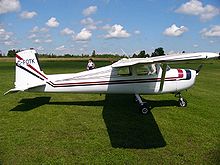 Cessna 150s produced before 1964, such as this 1962 Cessna 150B, lacked the later Omni-Vision rear window
Cessna 150s produced before 1964, such as this 1962 Cessna 150B, lacked the later Omni-Vision rear window
Marketing buzzwords
Cessna marketing buzzwords included:
- Para-Lift Flaps – these were the large fowler flaps Cessna introduced on the 170B in 1952, replacing the narrow chord plain flaps then in use.[41]
- Land-O-Matic – In 1956, Cessna introduced sprung-steel tricycle landing gear on the 172. The marketing department chose “Land-O-Matic” to imply that these aircraft were much easier to land and take off than the preceding conventional landing gear equipped Cessna 170. They even went as far as to say pilots could do “drive-up take-offs and drive-in landings”, implying that flying these aircraft was as easy as driving a car. In later years some Cessna models had their steel sprung landing gear replaced with steel tube gear legs. The 206 retains the original spring steel landing gear today.[41]
- Omni-Vision – This referred to the rear windows on some Cessna singles, starting with the 182 and 210 in 1962, the 172 in 1963 and the 150 in 1964. The term was intended to make the pilot feel visibility was improved on the notably poor-visibility Cessna line. The introduction of the rear window caused in most models a loss of cruise speed due to the extra drag, while not adding any useful visibility.[41]
- Cushioned power – This was to announce the introduction of rubber mounts on the cowling of the 1967 model 150, in addition to the rubber mounts isolating the engine from the cabin.
- Omni-Flash - This referred to the flashing beacon on the tip of the fin that could be seen all around.
- Open-View – This referred to the removal of the top section of the control wheel in 1967 models. These had been rectangular, they now became “ram’s horn” shaped, thus not blocking the instrument panel as much.
- Quick-Scan – Cessna introduced a new instrument panel layout in the 1960s and this buzzword was to indicate Cessna’s panels were ahead of the competition.
- Nav-O-Matic - This was the name of the Cessna autopilot system, which implied the system was relatively simple.
- Camber-Lift - This marketing name was used to describe Cessna aircraft wings starting in 1972 when the aerodynamics designers at Cessna added a slightly drooped leading edge to the standard NACA 2412 airfoil used on most of the light aircraft fleet. Writer Joe Christy described the name as "stupid" and added "Is there any other kind [of lift]?"[42]
Aircraft models
Main article: List of Cessna modelsCurrently Cessna has the following models in production:[43]
- Cessna 162 - high-wing, single piston engined, two-seat light aircraft in production since 2009
- Cessna 172 - high-wing, single piston engined, four-seat aircraft in production since the 1950s
- Cessna 182 - high-wing, single piston engined, four-seat aircraft in production since 1996 (was originally produced between 1956 and 1985)
- Cessna 206 - high-wing, single piston engined utility aircraft in production since 1962.
- Cessna 208 - high-wing turboprop utility aircraft in production since 1984.
- Cessna 400 - a turbo-charged variant of the Cessna 350, in production since 2004
- Cessna 510 - twin-engined very light business jet produced since 2005.
- Cessna 525 - twin-engined light business jet produced since 1991.
- Cessna 560 - twin-engined small-to-medium business jet produced since 1987.
- Cessna 560XL - twin-engined small-to-medium business jet produced since 1996.
- Cessna 680 - twin-engined mid-sized business jet produced since 2004.
- Cessna 750 - twin-engined long-range medium business jet aircraft produced since 1996.
References
- ^ Grady, Mary (May 2011). "A New CEO For Cessna". http://www.avweb.com/avwebflash/news/ANewCEOForCessna_204742-1.html. Retrieved 31 May 2011.
- ^ Cessna Aircraft Company (2011). "About Cessna - Overview". http://www.cessna.com/about-cessna.html. Retrieved 2011-10-29.
- ^ Article in "Enid News"
- ^ History of Cessna 1927
- ^ History of Cessna from 1929
- ^ Phillips, Edward H: Wings of Cessna, Model 120 to the Citation III, Flying Books, 1986. ISBN 0-911139-05-2
- ^ History of Cessna 1933
- ^ History of Cessna 1937
- ^ History of Cessna 1940
- ^ Flying Magazine: 78. August 1945.
- ^ History of Cessna 1946
- ^ History of Cessna 1948
- ^ History of Cessna 1955
- ^ History of Cessna 1956
- ^ History of Cessna 1960
- ^ history of Cessna 1963
- ^ History of Cessna 1969
- ^ History of Cessna 1975
- ^ History of Cessna 1985
- ^ History of Cessna 1992
- ^ Textron (November 2007). "Textron's Cessna Aircraft Company to Acquire Assets of Columbia Aircraft". http://investor.textron.com/phoenix.zhtml?c=110047&p=irol-newsArticle&ID=1081833&highlight=. Retrieved 2007-11-28.
- ^ Russ Niles (2007-11-27). "Cessna Gets Columbia". http://www.avweb.com/avwebflash/news/Cessna_Buys_ColumbiaAircraftManufacturing_196671-1.html. Retrieved 2007-11-29.
- ^ Textron (November 2007). "Cessna Chooses China's Shenyang Aircraft Corporation as Manufacturing Partner for Model 162 SkyCatcher". http://investor.textron.com/phoenix.zhtml?c=110047&p=irol-newsArticle&ID=1081831&highlight=. Retrieved 2007-11-28.
- ^ Russ Niles (2007-11-27). "Skycatcher To Be Made in China". http://www.avweb.com/avwebflash/news/Cessna_Skycatcher_MadeInChina_196672-1.html. Retrieved 2007-11-29.
- ^ a b Aniello, Tom (December 2007). "Making the case for building the SkyCatcher in China". Archived from the original on 2008-01-06. http://web.archive.org/web/20080106070032/http://www.cessnaskycatcher.com/home/124.html. Retrieved 2008-01-03.
- ^ Grady, Mary (January 2008). "Germany's Remos Aircraft Expanding, Challenges Cessna". http://www.avweb.com/avwebflash/news/RemosAircraft_Germany_Expanding_ChallengesCessna_196872-1.html. Retrieved 2008-01-03.
- ^ AvWeb Staff (January 2009). "Cessna Layoffs Continue". http://www.avweb.com/eletter/archives/avflash/1307-full.html. Retrieved 2009-02-02.
- ^ Grady, Mary F. (November 2008). "Cessna Slows Citation Production, Citing Global Economy". http://www.avweb.com/avwebbiz/news/CessnaSlowsCitationProduction_CitingGlobalEconomy_199121-1.html. Retrieved 2008-11-06.
- ^ Niles, Russ (November 2008). "It's a Buyer's Market". http://www.avweb.com/news/aopa/AOPAExpo2008_CessnaAircraft_BuyersMarket_199162-1.html. Retrieved 2008-11-08.
- ^ Durden, Chris (November 2008). "Cessna Announces Possible Layoffs". http://www.kwch.com/Global/story.asp?S=9292651&nav=menu486_2_3. Retrieved 2008-11-04.
- ^ Niles, Russ (November 2008). "Eclipse Misses Payroll: TV Report". http://www.avweb.com/avwebflash/news/EclipseAviation_Misses_Payroll_TVreport_199202-1.html. Retrieved 2008-11-13.
- ^ Pew, Glenn (January 2009). "Cessna Layoffs Continue". http://www.avweb.com/avwebflash/news/cessna_layoff_wichita_textron_pelton_199682-1.html. Retrieved 2009-02-02.
- ^ Grady, Mary (April 2009). "Cessna Will Suspend Columbus Program, Close Bend Factory". http://www.avweb.com/avwebflash/news/CessnaWillSuspendColumbusProgramAndCloseBendFactory_200284-1.html. Retrieved 2009-04-30.
- ^ Grady, Mary (July 2009). "Goodbye, Columbus -- Cessna Cancels Extra-Large Jet Program". http://www.avweb.com/avwebflash/news/CessnaCancelsExtraLargeColumbusJetProgram_200720-1.html. Retrieved 2009-07-16.
- ^ Pew, Glenn (June 2009). "More Layoffs At Cessna". http://www.avweb.com/avwebflash/news/cessna_layoff_wichita_columbus_mustang_200511-1.html. Retrieved 2009-06-08.
- ^ Pew, Glenn (Deecmber 2009). "Cessna Closing Plants, Cutting Jobs". http://www.avweb.com/avwebflash/news/cessna_columbus_mccauley_jobs_cut_wichita_mexico_201673-1.html. Retrieved 2009-12-14.
- ^ Niles, Russ (April 2010). "Cessna Declines Sap Textron Revenues". http://www.avweb.com/avwebbiz/news/CessnaDeclinesSapsTextron_202461-1.html. Retrieved 28 April 2010.
- ^ Grady, Mary (September 2010). "Cessna To Cut 700 Jobs". http://www.avweb.com/avwebflash/news/CessnaToCut700Jobs_203322-1.html. Retrieved 23 September 2010.
- ^ Press release by Cessna Aircraft Company
- ^ Pew, Glenn (September 2011). "Corvalis Wing Prompts $2.4 Million Proposed Fine". AVweb. http://www.avweb.com/avwebflash/news/cessna_corvalis_wing_composite_fine_FAA_205442-1.html. Retrieved 24 September 2011.
- ^ a b c Clarke, Bill: Cessna 150 and 152 first edition, pages 5–17. TAB Books, 1987. ISBN 0-8306-9002-0
- ^ Christy, Joe: The Complete Guide to the Single Engine Cessnas - Third Edition, page 119. TAB Books, 1979. ISBN 0-8306-2268-3
- ^ Cessna Aircraft (2009). "Aircraft Comparison". http://www.cessna.com/. Retrieved 31 December 2010.
External links
- Company website
- PilotFriend.com - Cessna company history and aircraft types details
- "Patents owned by Cessna Aircraft Company". US Patent & Trademark Office. http://patft.uspto.gov/netacgi/nph-Parser?Sect1=PTO2&Sect2=HITOFF&u=%2Fnetahtml%2Fsearch-adv.htm&r=0&p=1&f=S&l=50&Query=an%2F%22Cessna+Aircraft+Company%22&d=ptxt. Retrieved December 5, 2005.
Cessna aircraft Single-engine A · AA · AC · AF · AS · AW · BW · CR-2 · CR-3 · CW-6 · EC-1 · EC-2 · DC-6 · C-34 · C-37 · C-38 · C-145 · C-165 · 120 · 140 · 150 · 152 · 160 · 162 · 170 · 172 · 175 · 177 · 180 · 182 · 185 · 187 · 188 · 190 · 195 · 205 · 206 · 207 · 208 · 210 · 305 · 308 · 309 · 319 · 321 · 325 · 350 · 400 · 1014 · 1034 · NGP · XMC
Multi-engine Cessna Citation
familiesHelicopters Gliders Military Lists relating to aviation General Aircraft (manufacturers) · Aircraft engines (manufacturers) · Airlines (defunct) · Airports · Civil authorities · Museums · Registration prefixes · Rotorcraft (manufacturers) · TimelineMilitary Accidents/incidents Records
Wikimedia Foundation. 2010.

